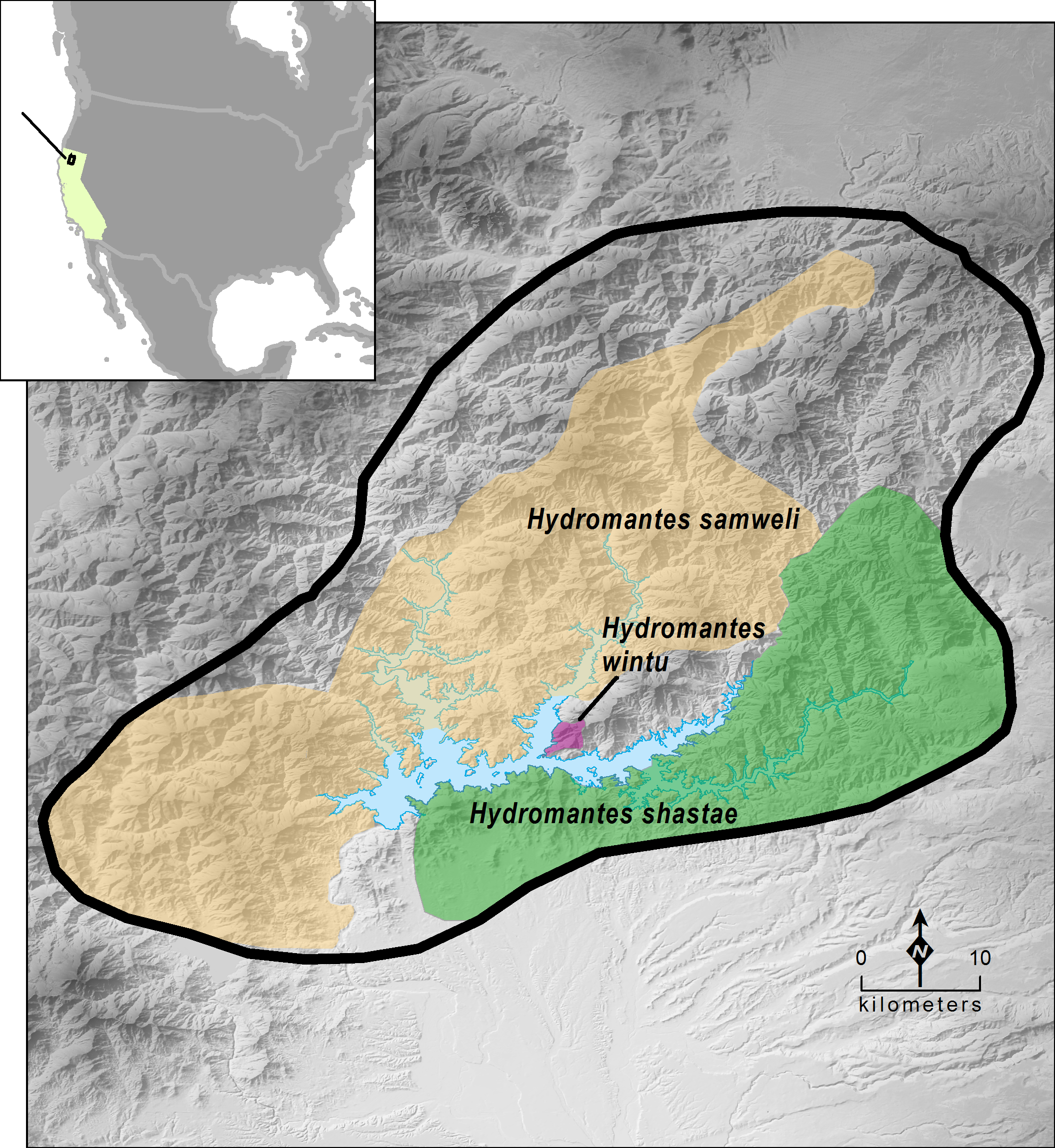|
Hydromantes wintu Bingham, Papenfuss, Lindstrand & Wake, 2018
Wintu Shasta Salamander Subgenus: Hydromantes | family: Plethodontidae subfamily: Plethodontinae genus: Hydromantes |
| Species Description: Bingham RE, Papenfuss TJ, Lindstrand III L, Wake DB 2018 Phylogeography and species boundaries in the Hydromantes shastae complex, with description of two new species (Amphibia: Caudata: Plethodontidae). Bulletin of the Museum of Comparative Zoology, 161: 403-427. | |
|
Etymology: The species epithet, “wintu” is in honor of the Winnemem Wintu Tribe, the original inhabitants of where the species is found (Bingham et al. 2018). |
|
 © 2024 Noah M. Morales (1 of 4) |
|
|
|
Description The species differ in measurements analyzed used in a multivariate morphometrics analysis but otherwise the three species are separated by allozymic and DNA sequence differences. This species differs from H. shastae in having a shorter digit 3 on the foot. The maxillary teeth of the males are elongate and oriented on the bone so as to protrude from the side of the mouth (Bingham et al. 2018). In life, these salamanders have a generally gray to gray-brown coloration with yellowish or reddish highlights, and the gray color has a metallic sheen. The lower surfaces are a flat gray color. The iris is a bright, metallic, pale yellow on the upper region. In preservative, the specimens are various shades of cinnamon (Bingham et al. 2018). Distribution and Habitat Country distribution from AmphibiaWeb's database: United States U.S. state distribution from AmphibiaWeb's database: California
The species is endemic to limestone dominated local habitats in a geographically restricted area of no more than 5 km2 along and between Marble Creek and Potter Creek at the end of the Shasta Reservoir peninsula lying between the McCloud river arm and the main Pit River arm of the reservoir, on the McCloud side, Shasta County, northern California. The vegetation in the region is a mosaic of hardwood, conifer, and hardwood-conifer forest with chaparral inclusions. Winters are cool and wet, and surface activity occurs during this time; salamanders can be found under rocks and other surface cover. Summers are long periods (5 to 7 months) of hot, very dry weather, and underground retreats are essential. Caves and limestone fissures are used, especially during the summer. The species is distributed discontinuously, in generally small patches of habitat (Bingham et al. 2018). To illustrate the distributions of the H. shastae group, the map shows Hydromantes shastae in green, H. samweli in orange, and H. wintu in pink (after Bingham et al 2018); the previous range map for H. shastae is outlined in black. Life History, Abundance, Activity, and Special Behaviors Members of the shastae species complex are excellent climbers and use their webbed toes to climb on sheer, slippery rock surfaces (Gorman and Camp 1953). Eggs have been found in moist caves during the summer (Gorman 1956). The species is locally common on the surface during moist periods in fall, winter and spring seasons. Trends and Threats At present this species is safely away from humans in a road-less and trail-less area and can be reached only by boat. Comments
References
Bingham, R. E., Papenfuss, T. J., Lindstrand III, L., Wake, D. B. (2018). ''Phylogeography and species boundaries in the Hydromantes shastae complex, with description of two new species (Amphibia: Caudata: Plethodontidae).'' Bulletin of the Museum of Comparative Zoology, 161(10), 403-427. Gorman, J. (1956). ''Reproduction in plethodontid salamanders of the genus Hydromantes.'' Herpetologica, 12, 249-259. Gorman, J. and Camp, C. L. (1953). ''A new cave species of salamander of the genus Hydromantes from California, with notes on habits and habitats.'' Copeia, 1953, 39-43. Originally submitted by: David B. Wake (first posted 2018-08-14) Distribution by: Michelle S. Koo (updated 2025-05-12)
Comments by: Michelle S. Koo (updated 2025-05-12)
Edited by: Ann T. Chang, Michelle S. Koo (2025-05-12) Species Account Citation: AmphibiaWeb 2025 Hydromantes wintu: Wintu Shasta Salamander <https://amphibiaweb.org/species/8812> University of California, Berkeley, CA, USA. Accessed May 20, 2025.
Feedback or comments about this page.
Citation: AmphibiaWeb. 2025. <https://amphibiaweb.org> University of California, Berkeley, CA, USA. Accessed 20 May 2025. AmphibiaWeb's policy on data use. |



 Map of Life
Map of Life